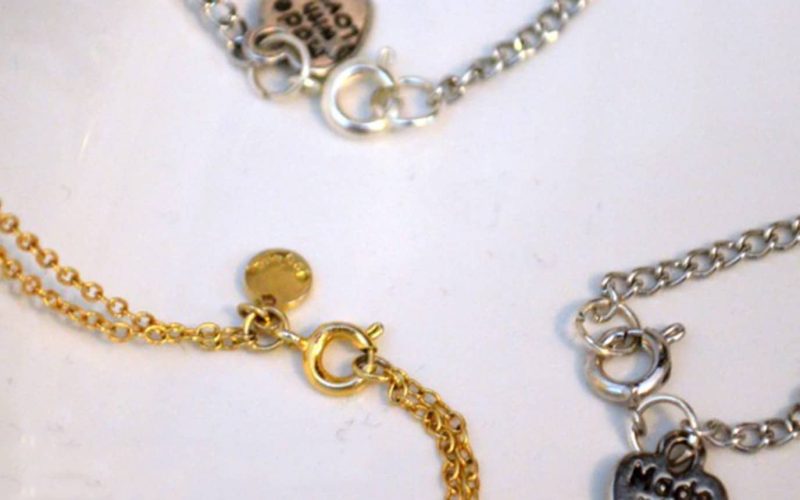People tend to overlook a bracelet clasp when choosing jewelry or a bracelet. Some people don’t even know what a clasp means.
A clasp mechanism makes it easy for a bracelet to be put on or off without damage. And it is one of the essential things to consider when buying a bracelet.
If you are a jewelry lover, you have come to the right place because this article discusses the different types of bracelet clasps.
1. Spring Ring Clasp
When it comes to clasps made of metal, the round shape is one of the most popular types of bracelet clasps. It opens when you push back on a small lever that moves around the circle.
Once the clasp is open, slip the chain or loop from the connecting piece into the open circle. Then, push the lever to close the clasp again.
Some people may have trouble with this clasp because they don’t have long nails. So, if you love this clasp, your nails must be long.
You’ll find this clasp on necklaces and anklets too. However, people who can’t handle little things should not consider getting this clasp.
2. Lobster Clasp
The lobster clasp is the most popular among the different bracelet clasps. Due to its resemblance to a lobster claw, people named it the lobster clasp.
Lobster clasps are the most secure and long-lasting clasps available.
To open the claw, you only need to press down on the small lever. When you release the lever, the claw will automatically close.
One of its finest features is that it is spring-loaded and self-closing. Moreover, it has a sleek appearance and is available in various sizes and materials.
Further, the weight of a jewelry piece will determine the size of a lobster clasp. Some are quite small, so if you have long nails or poor dexterity, you may find it difficult to open them.
3. Barrel Clasp
A barrel clasp is another beautiful clasp among the different bracelet clasps. Torpedo clasps are another name for barrel clasps.
When the clasp twists closed, it resembles a barrel, thus the name. They comprise two small cylindrical components that are connected by a screw.
You must twist one end to the other to use the clasp, which needs both hands. So, if you see this clasp on a bracelet, you might need help putting it on and off.
Although it’s still a safe pick, its design might scare buyers away because it’s complicated.
4. Box Clasp
A box clasp is among the different types of bracelet clasps, too. It has a box frame on one end and a wedge-shaped tab.
They’re two-piece tongue-and-groove clasps that have two parts. Put the tab into the frame of the box. Then, let the clasp click into place.
Push down on the outside of the tap until it comes out of the box frame. Box clasps can be decorated with jewels to match the jewelry’s look.
They’re not good for heavy jewelry, even though they’re strong. One disadvantage of the box clasp is that it can become stuck, and attempting to remove it can spoil it.
5. Magnetic Clasp
The magnetic clasp seems the easiest to wear among the different types of bracelet clasps. This clasp comprises magnets that snap together and securely lock any jewelry.
It comes in various shapes and sizes, including round and rectangular. They’re usually inexpensive and go well with handcrafted jewelry or stylish items.
Simple designs are available, but embellished magnets with filigree work are also available.
While this clasp is cute and simple, it isn’t the most durable.
A strong yank can break the link between the magnets, resulting in the loss of your jewelry.
6. Bolo Clasp
Bolo clasps are trendy and ideal for sliding bracelets and necklaces. They enable you to alter the jewelry to your exact specifications.
Bolo clasps are often used in bracelets and lariat necklaces. They’re simple to put on and adjust, providing various options for how your jewelry should fit.
The clasp can play a significant part in the jewelry’s variable design.
7. Fishhook Clasp
Fishhook clasps are among the different bracelet clasps but are not very popular. These are delicate yet secure clasps that add a touch of elegance to lightweight jewelry. They’re pretty attractive, and they can add jewels to the design.
This fastener has a beautiful oval-shaped casing on one end and an inner hook shaped like a fishhook. You must put the hook into the oval casing or a box and press in until it snaps into place to close it.
However, you must squeeze the hook and drag it out of the casing to open the clasp.
8. Toggle Clasp
Toggle clasps are fashionable and laid-back. They’re ideal for gemstone jewelry or statement pieces with a clasp integral to the design.
Toggle clasps maintain the bar in place and are ideal for larger, heavier jewelry pieces. It’s a very safe clasp that can hold any jewelry.
Putting a toggle clasp on might be difficult, especially if you’re doing it with one hand. Nonetheless, it is extremely secure once in place.
9. Screw Clasp
Screw clasps work by screwing one end of a fastener into the other, securely retaining a piece of jewelry. They are available in various sizes and forms.
They’re commonly barrel-shaped, but we can also find them in spheres or cylinders. The threaded construction prevents the jewelry piece from opening, which is the real benefit of a screw fastener.
The disadvantage of the screw clasp is that screwing the two components together takes time and precision. This can be aggravating, particularly if you’re in a rush.
10. Buckle Clasp
The buckle clasp is another bracelet clasp, but it is rare. We’ll mostly find this clasp type in a leather bracelet resembling a belt buckle. The buckle clasp can turn any jewelry into a show-stopping piece of art.
11. Slide Lock Clasp
This clasp has two tubes or bars, one sliding into the other and falling into place. These two parts are sometimes magnetic to make them more secure.
These are commonly used for multi-strand jewelry because they have longer bars with several smaller rings on their sides.
Moreover, these clasps are a popular choice for artisan jewelry since they are elegant and cheap.
12. Push Clasp
These clasps function like a snap hook. You can open the clasp and hook your jewelry piece by pushing in the one-way hinge from the outside using your fingernail.
One exciting aspect of this clasp is that it can be operated with one hand, making it ideal for bracelets and necklaces.
However, it isn’t very secure because even the tiniest external pressure can open it.








